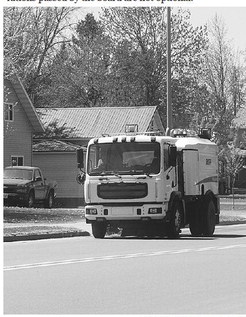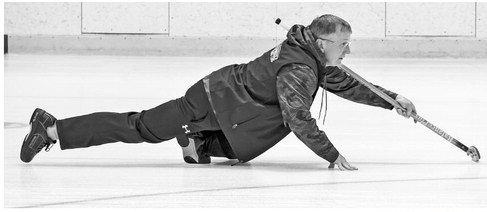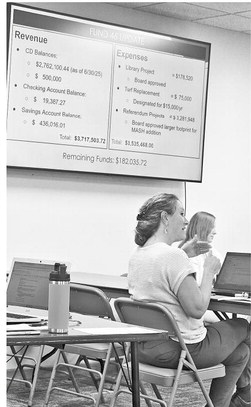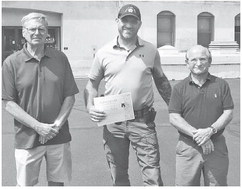Medford curlers competed in Iceland in the Akureyri Ice Cup
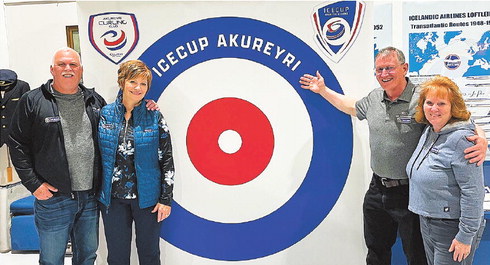

How far would you go to curl?
For a group of curlers from the Medford Curling Club, that question had them halfway around the world, and just south of the Arctic Circle in Akureyri, Iceland competing in the Akureyri Ice Cup from May 1 to 3.
The competition included teams from around Europe and the United States. Representing Medford at the international competition was “Team Sapsucker” made up of Jeff and Kathy Hemer, David “Beaner” Lemke and Connie Bergman. The Medford team had a strong showing in the bonspiel taking sixth place overall out of 26 teams with a record of two wins and two ties. They narrowly missed getting into the finals.
The journey to Iceland for the team started two years ago when Jeff learned about it and got on the waiting list to get in. Late last summer he was contacted by organizers that a spot opened up. “We had to make a decision pretty fast,” Jeff explained noting they were happy that Connie and Beaner said yes to going. He compared the trip with the times he would go to Quebec to curl with Jim Peterson. “You feel foreign,” he said. “We were outside of our comfort zones.”
The team left from Minneapolis on April 26 and had a direct flight to an airport just outside of Reykjavik, Iceland, which is about the size of the state of Wisconsin. The flight was about six hours long and brought them across five time zones. They had come in early to do sightseeing before the start of the bonspiel. Reykjavik is located on the southwest corner of Iceland and Akureyri is on the northwest corner of the island. They rented a car and drove a route recommended by one of the bonspiel organizers that took them along the country’s eastern coast.
“Iceland truly is a land of fire and ice,” Jeff said. He explained that the population of about 300,000 people lives on the coast with fishing as the primary industry followed by tourism. The terrain is rocky with volcanoes and glaciers. The interior of the island is largely uninhabited because of its rugged terrain.
A benefit of the active volcanos is the presence of hot pools and the abundance of geothermal energy. “Heat is pretty much free,” Jeff said, noting there were steam pipelines leading to people’s homes. Likewise electricity costs are also low, while other costs like food are higher because they have to be imported.
Along the way to the bonspiel, they stopped and toured at various locations including impressive waterfalls at Dettifoss and Goðafoss and glacier tours at Jokulsarlon.
On one day, they took an excursion into a glacier bay. Connie described being on the rubber dingy with the person in charge navigating around the icebergs floating in the water.
“We got to taste a glacier,” Jeff said, noting the guide told them it was about a 2,000 year old pice of ice. Jeff said he especially enjoyed visiting the public hot springs.
The bonspiel was held in the community of Akureyri which has a population of about 20,000 people. It is the second largest population area in Iceland after the capital region. The Norse Viking Helgi Eyvindarson originally settled the area in the 9th century and the name Akureyri has been in use since the middle of the 1500s.
Connie noted that about the only downside of touring before the bonspiel was that their legs were sore before they started curling.
All the of members of the Medford team praised the friendliness of the people they met and the work put in by the organizers of the bonspiel. “The people were all really friendly,” Connie said. Culturally people from Iceland are generally more quiet and stoic than here in America.
“The people at the curling club were great guys,” Beaner said. He said he regrets not having had the opportunity to talk with more of the teams. The rink where the bonspiel was located only had a small warming room area so there wasn’t much opportunity to socialize with people outside their pool.
Kathy noted that while food and fellowship are major parts of bonspiels in Wisconsin, in Iceland they offered lamb soup and grilled cheese as the food options and that there wasn’t a baked treat to be seen anywhere.
They did get to experience some local delicacies with a reception held at one of the organizers’ “Man Cave.” They had a chance to sample things like fermented shark on rye bread, smoked horse, sour ram testicles, and a pickled sheep’s head. Kathy said they were grateful to have gone back to their hotel before the partying had gotten to the point of seeing someone eat the sheep’s eye.
All of the team members said the bonspiel experience was good, if at times frustrating compared to how they are
See CURLERS on page 12 used to seeing tournaments run.
Unlike the bonspiel formats used in America which have competition in brackets or use round robin to advance, European bonspiels use what is called the Schenkel system. Under this system, the teams start by being assigned to pools and after the second game are paired based on a point system with the goal of ensuring teams are playing evenly matched opponents in future rounds. Teams get points based on the outcome of their games with two points for a victory, one point for a tie and 0 points for a loss. The system then factors in the number of ends won in all games, the number of stone points scored and the stone ration based on the points scored to points given.
“The Schenkel system stunk,” Kathy said, noting that it was a challenge to know how your team was doing or even when you would be playing next because the pairings would depend on the outcome of games.
She noted that one team went back to their hotel after a game only to get called back and told they needed to be on the ice in less than 15 minutes.
“I’ve never been in a bonspiel where we didn’t lose a game but didn’t end up playing on Sunday,” Beaner said of the system which saw a team the Medford squad beat ended up competing in the finals due to points. Only the top four teams by point totals played in the finals with the top two in the gold medal match and the second two in the bronze medal match.
Jeff noted that if they had been able to turn one of the ties into a win, they would have been playing in the championship game, as it was they came home with a sixth place overall finish.
The bonspiel was played on arena ice at a communityowned facility that is primarily used for hockey. A lot of work went into preparing for the tournament.
The team’s first match-up of the tournament was against curlers from Iceland who were members of the ice-making crew. Jeff said they told him they flooded the ice four times in preparation for the bonspiel.
Jeff described the ice as being as fast as what Medford ice is like while Lemke noted it had about eight feet of curl.
“We are spoiled here in Medford,” Jeff said of having dedicated curling ice here.
The Akureyri Curling Club only has about 45 members who play on Monday nights. While the municipality in Akureyri doesn’t charge the club members for ice time, they only get a small window of time on Mondays to prep the ice, set the hacks and scrape and typically only have enough time to do three-end league games.
Jeff said he spoke to team members from Orlando, Fla. who were there who said that in Orlando, curlers only have ice time early Sunday morning.
“We are lucky here,” he said.
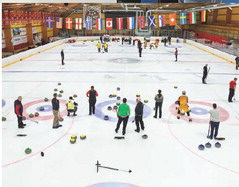
AKUREYRI CURLING CLUB PHOTO
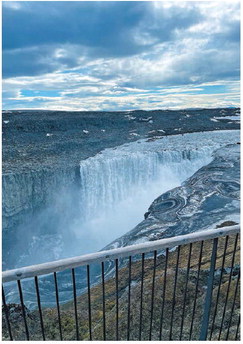
Iceland is located only a few degrees south of the Arctic Circle and sea ice, such as these, are common in their glacially-carved bays. During the trip the Medford curlers were able to go out on a boat in the water with the ice and even had a chance to sample some ice right from a glacier. (right) Iceland has a lot of water and a rugged terrain and the Medford curlers were awed by the many waterfalls such as this one. SUBMITTED
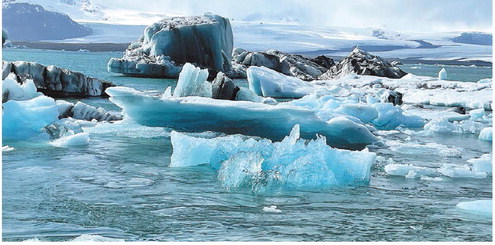
The event photographer captured a picture of Medford curler David “Beaner” Lemke just after releasing the rock during one of their games held as part of the Akureyri Ice Cup bonspiel held in Akureyri, Iceland earlier this month. AKUREYRI CURLING CLUB PHOTO
